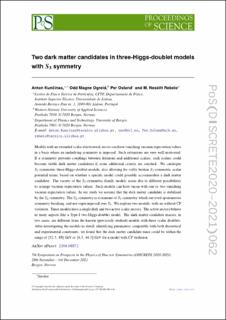| dc.contributor.author | Kuncinas, Anton | |
| dc.contributor.author | Øgreid, Odd Magne | |
| dc.contributor.author | Osland, Per | |
| dc.contributor.author | Rebelo, Margarida Nesbitt | |
| dc.date.accessioned | 2023-03-22T06:52:50Z | |
| dc.date.available | 2023-03-22T06:52:50Z | |
| dc.date.created | 2023-01-24T21:29:41Z | |
| dc.date.issued | 2022 | |
| dc.identifier.citation | Proceedings of Science (PoS). 2022, (062), . | en_US |
| dc.identifier.issn | 1824-8039 | |
| dc.identifier.uri | https://hdl.handle.net/11250/3059646 | |
| dc.description.abstract | Models with an extended scalar electroweak sector can have vanishing vacuum expectation values
in a basis where an underlying symmetry is imposed. Such extensions are very well motivated.
If a symmetry prevents couplings between fermions and additional scalars, such scalars could
become viable dark matter candidates if some additional criteria are satisfied. We catalogue
𝑆3-symmetric three-Higgs-doublet models, also allowing for softly broken 𝑆3-symmetric scalar
potential terms, based on whether a specific model could possibly accommodate a dark matter
candidate. The variety of the 𝑆3-symmetric family models arises due to different possibilities
to arrange vacuum expectation values. Such models can have vacua with one or two vanishing
vacuum expectation values. In our study we assume that the dark matter candidate is stabilised
by the Z2 symmetry. The Z2 symmetry is a remnant of 𝑆3 symmetry which survived spontaneous
symmetry breaking, and not superimposed over 𝑆3. We explore two models; with an without CP
violation. These models have a single dark and two active scalar sectors. The active sectors behave
in many aspects like a Type-I two-Higgs-doublet model. The dark matter candidate masses, in
two cases, are different from the known (previously studied) models with three scalar doublets.
After investigating the models in detail, identifying parameters compatible with both theoretical
and experimental constraints, we found that the dark matter candidate mass could be within the
range of [52.5, 89] GeV or [6.5, 44.5] GeV for a model with CP violation. | en_US |
| dc.language.iso | eng | en_US |
| dc.publisher | Sissa Medialab | en_US |
| dc.rights | Attribution-NonCommercial-NoDerivatives 4.0 Internasjonal | * |
| dc.rights.uri | http://creativecommons.org/licenses/by-nc-nd/4.0/deed.no | * |
| dc.title | Two dark matter candidates in three-Higgs-doublet models with S3 symmetry | en_US |
| dc.type | Peer reviewed | en_US |
| dc.type | Journal article | en_US |
| dc.description.version | publishedVersion | en_US |
| dc.rights.holder | © Copyright owned by the author(s) under the terms of the Creative Commons | en_US |
| dc.source.pagenumber | 6 | en_US |
| dc.source.journal | Proceedings of Science (PoS) | en_US |
| dc.source.issue | 062 | en_US |
| dc.identifier.doi | https://doi.org/10.22323/1.405.0062 | |
| dc.identifier.cristin | 2114335 | |
| cristin.ispublished | true | |
| cristin.fulltext | original | |
| cristin.qualitycode | 1 | |

